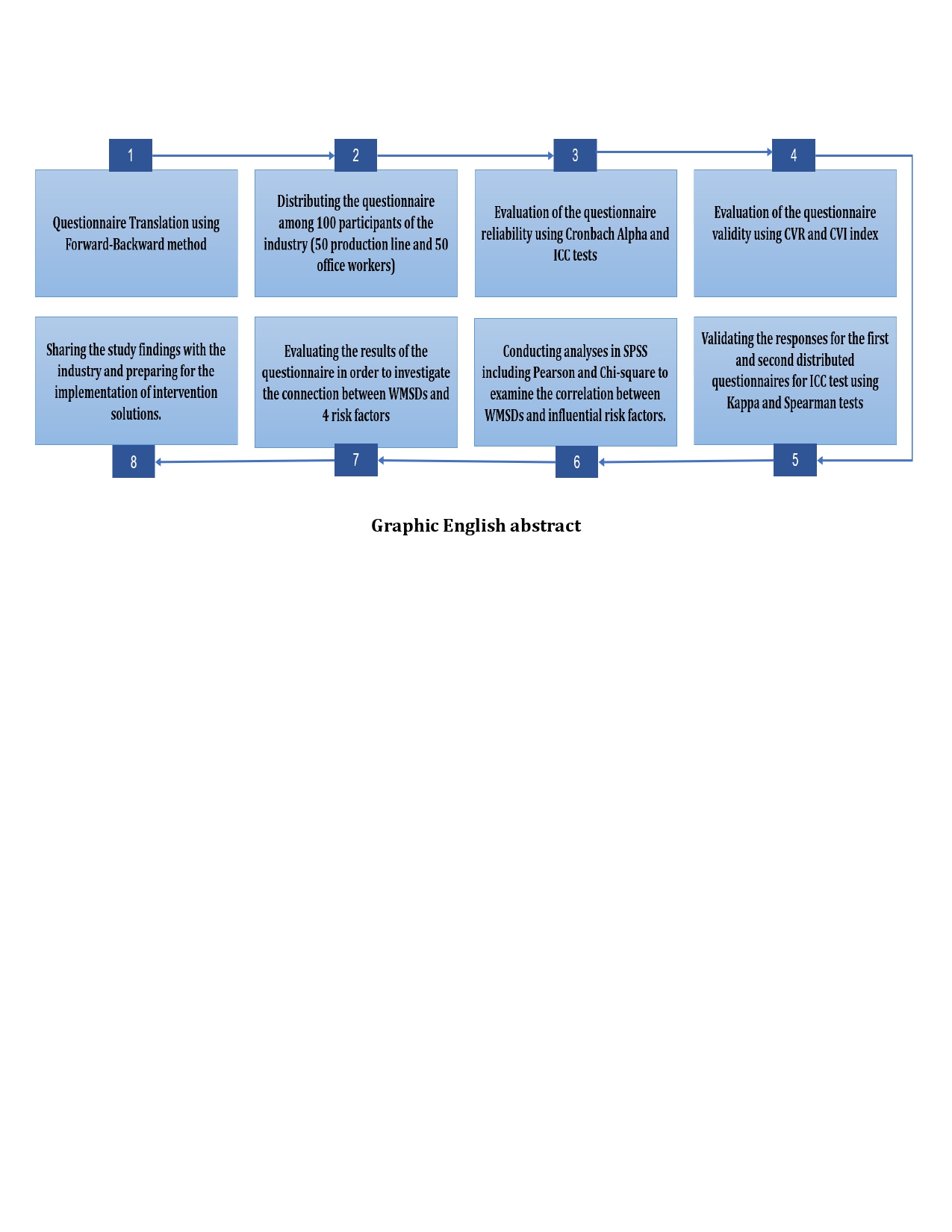Volume 13, Issue 4 (12-2023)
J Health Saf Work 2023, 13(4): 714-735 |
Back to browse issues page
Download citation:
BibTeX | RIS | EndNote | Medlars | ProCite | Reference Manager | RefWorks
Send citation to:



BibTeX | RIS | EndNote | Medlars | ProCite | Reference Manager | RefWorks
Send citation to:
SheikhMozafari M J, Mirnajafi Zadeh F S, Sasani Nasab N, Mohammad Alizadeh P, Biganeh J, Zakerian S A. Investigating the prevalence of musculoskeletal disorders and its relationship with physical and psychosocial risk factors among an automotive industry employees: Validating the MDRF questionnaire. J Health Saf Work 2023; 13 (4) :714-735
URL: http://jhsw.tums.ac.ir/article-1-6906-en.html
URL: http://jhsw.tums.ac.ir/article-1-6906-en.html
Mohammad Javad SheikhMozafari1 
 , Fatemeh Sadat Mirnajafi Zadeh1
, Fatemeh Sadat Mirnajafi Zadeh1 
 , Neda Sasani Nasab2
, Neda Sasani Nasab2 
 , Parsa Mohammad Alizadeh3
, Parsa Mohammad Alizadeh3 
 , Jamal Biganeh1
, Jamal Biganeh1 
 , Seyed Abolfazl Zakerian *
, Seyed Abolfazl Zakerian * 
 4
4

 , Fatemeh Sadat Mirnajafi Zadeh1
, Fatemeh Sadat Mirnajafi Zadeh1 
 , Neda Sasani Nasab2
, Neda Sasani Nasab2 
 , Parsa Mohammad Alizadeh3
, Parsa Mohammad Alizadeh3 
 , Jamal Biganeh1
, Jamal Biganeh1 
 , Seyed Abolfazl Zakerian *
, Seyed Abolfazl Zakerian * 
 4
4
1- Department of Occupational Health Engineering, School of Public Health, Tehran University of Medical Sciences, Tehran, Iran
2- Virtual school of Medical Education and Management, Shahid Beheshti University of Medical sciences, Tehran, Iran
3- Department of Occupational Health Engineering, Faculty of medical science, Tarbiat Modares university, Tehran, Iran
4- Department of Occupational Health Engineering, School of Public Health, Tehran University of Medical Sciences, Tehran, Iran ,zakerian@tums.ac.ir
2- Virtual school of Medical Education and Management, Shahid Beheshti University of Medical sciences, Tehran, Iran
3- Department of Occupational Health Engineering, Faculty of medical science, Tarbiat Modares university, Tehran, Iran
4- Department of Occupational Health Engineering, School of Public Health, Tehran University of Medical Sciences, Tehran, Iran ,
Abstract: (1334 Views)
Introduction: Work-related musculoskeletal disorders (WMSDs) are a prevalent occupational health concern, influenced by both physical and psychosocial factors. Valid questionnaires offer a cost-effective and efficient means of evaluating WMSDs. This study aimed to validate the Persian version of the MDRF questionnaire, assess its applicability in Iran, and investigate the prevalence of WMSDs among employees in an automotive industry.
Material and Methods: This descriptive cross-sectional study was conducted among 100 employees (50 production line workers and 50 office workers) in Kerman province. The linguistic validity of the questionnaire and its translation were ensured using the Backward-Forward method. Content validity was assessed through CVI and CVR indexes. To evaluate the questionnaire’s reliability and agreement, Cronbach’s alpha and ICC were employed. User responses from the first and second series of the questionnaires were validated using Kappa and Spearman’s tests.
Results: Results indicated high reliability which was achieved by Cronbach’s alpha and ICC values of 0.960 and 0.925, respectively. The questionnaire’s validity was acceptable based on CVR and CVI tests. The prevalence of WMSDs was the highest in the lower back for both production line and office workers over the past year. The job satisfaction factor exhibited the highest risk level among the questionnaire’s four subgroups. Approximately 85% of participants were classified as having a high or very high-risk level, reflecting concerning conditions among the employees. The prevalence of WMSDs in different body parts significantly correlated with all physical and psychosocial stress factors.
Conclusion: This research highlights the influence of diverse physical and psychosocial risk factors on the occurrence of WMSDs among both occupational workers and office employees. Also, the MDRF questionnaire, whose high applicability in assessing the WMSDs risk factors was proven in this study, is an effective tool for prioritizing, planning, and executing educational and preventive measures within the workforce community to mitigate and prevent WMSDs.
Material and Methods: This descriptive cross-sectional study was conducted among 100 employees (50 production line workers and 50 office workers) in Kerman province. The linguistic validity of the questionnaire and its translation were ensured using the Backward-Forward method. Content validity was assessed through CVI and CVR indexes. To evaluate the questionnaire’s reliability and agreement, Cronbach’s alpha and ICC were employed. User responses from the first and second series of the questionnaires were validated using Kappa and Spearman’s tests.
Results: Results indicated high reliability which was achieved by Cronbach’s alpha and ICC values of 0.960 and 0.925, respectively. The questionnaire’s validity was acceptable based on CVR and CVI tests. The prevalence of WMSDs was the highest in the lower back for both production line and office workers over the past year. The job satisfaction factor exhibited the highest risk level among the questionnaire’s four subgroups. Approximately 85% of participants were classified as having a high or very high-risk level, reflecting concerning conditions among the employees. The prevalence of WMSDs in different body parts significantly correlated with all physical and psychosocial stress factors.
Conclusion: This research highlights the influence of diverse physical and psychosocial risk factors on the occurrence of WMSDs among both occupational workers and office employees. Also, the MDRF questionnaire, whose high applicability in assessing the WMSDs risk factors was proven in this study, is an effective tool for prioritizing, planning, and executing educational and preventive measures within the workforce community to mitigate and prevent WMSDs.
Keywords: Work-related musculoskeletal disorders, MDRF questionnaire, Automotive industry, Physical and psychosocial risk factors
Type of Study: Research |
Received: 2024/01/1 | Accepted: 2023/12/31 | Published: 2023/12/31
Received: 2024/01/1 | Accepted: 2023/12/31 | Published: 2023/12/31
Send email to the article author
| Rights and permissions | |
 |
This work is licensed under a Creative Commons Attribution-NonCommercial 4.0 International License. |




